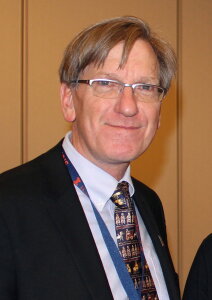
Contact Information
123 Davenport Hall
607 S Mathews Ave
Urbana, IL 61801
M/C 148
Urbana, IL 61801
Biography
I am an archaeologist interested in the broad relationships between history and humanity, materiality and agency, affect and ontology, and religion and urbanism. My focus in on North America, and my concerns range from local historical ones, particularly in the central Mississippi valley, to pan-American and big-historical ones, especially as they involve Mesoamerican-Southwestern-Mississippi valley connections. I have conducted most of my field research at and around the American Indian city of Cahokia or related complexes, having held posts at the University of Oklahoma, the State University of New York (Buffalo) and the University of Illinois.
Research Interests
Materiality, affect and agency; Religion and ontologies; Cities and landscapes; Global medievalism; Climate change; North American archaeology; Woodland and Mississippian cultures; Indigenous Prairie-Plains history; Pottery.
Research Description
Among the most enduring yet pressing social-scientific and humanistic concerns of great significance to the contemporary world is the relationship between belief and history. Why do people believe what they do? My archaeological research interrogates that ultimate question by focusing on proximate how questions. How are religion, ontology, urbanism, materiality, affects, and power in the past related? Or how are space, matter, and time entangled and to what effect? I seek answers to such questions in the beginnings of urbanism, city life, and organized religion, specifically in North America through fieldwork in the pre-Columbian Mississippi valley. My approach has always been one that blends social theory with thick historical descriptions rich with the things, houses, foods, stimulants and the varied experiences of everyday agrarian life. These are the contexts wherein people and other-than-human agencies might be subsumed within larger social, political and cultural orders in ways that profoundly alter social futures. Understanding them necessitates an archaeology that bridges the humanities and social sciences, and that takes seriously its mission to positively affect our global future. This is the goal to which I aspire through my research, teaching, and everyday engagements in the world.
In 2008, I began to write An Archaeology of the Cosmos (Routledge, 2013), a significant departure for me both theoretically and methodologically. That book defined my thinking on questions of agency, religion, and history. There, I began to build my own version of a “relational approach” in archaeology (drawing from Bruno Latour, Gilles Deleuze and others) by developing what can be labeled a theory of “bundling” (see also a co-edited volume, Big Histories, Human Lives, SAR Press, 2013). The result is both a less-anthropocentric approach to religious movements and a less landscape-tethered approach to social experience, where agency is a consequence of the convergences of phenomena and beings in social fields that stretch into the sky. This is the rapprochement of agency-based approaches, which tend to focus on short-term microhistories, with the traditional long-term changes covered by archaeologists. This book was the basis for my current field research as well, which targets the beginnings of organized religion at the Emerald Acropolis and other early Cahokian shrine complexes. All of this was also a necessary precursor to Gods of Thunder (Oxford, 2023), written in part during a 2015-2016 NEH fellowship.
Education
Ph.D. 1991, Anthropology, University of Michigan, Ann Arbor (UM). M.A. 1986, Anthropology, Southern Illinois University, Carbondale (SIU-C). B.S. 1983, Anthropology and Earth Science, Southern Illinois University, Edwardsville (SIU-E).
Additional Campus Affiliations
Professor, Anthropology
Principal Research Scientist, Illinois State Archaeological Survey
Recent Publications
Aiuvalasit, M. J., Lambert, J. M., Pauketat, T. R., & White, A. A. (Eds.) (2024). An Assessment of the Impacts of Climate Change on Cultural Heritage in Illinois. Illinois State Archaeological Survey. https://hdl.handle.net/2142/125136
Pauketat, T. R., Alt, S. M., Alleen M., B., Jeffery D., K., & Benson, EM. (2023). Cahokia as Urban Anomaly. Journal of Urban Archaeology, 7, 253-274. https://doi.org/10.1484/J.JUA.5.133458
Pauketat, T. R., McCullough, R. G., Alt, S. M., Kruchten, J. D., Wilson, C. V., Farkas, M. G., Bandy, B. E., Malouchos, E. W., & Buchanan, M. E. (2023). Circular Mounds and Sweat Lodges in the Greater Cahokia Region. Midcontinental Journal of Archaeology, 48(3), 227-268. https://doi.org/10.5406/23274271.48.3.03
Pauketat, T. R. (2023). Gods of Thunder: How Climate Change, Travel, and Spirituality Reshaped Precolonial America. Oxford University Press. https://doi.org/10.1093/oso/9780197645109.001.0001
Emerson, T. E., Hedman, K. M., Brennan Blodgett, T. K., Betzenhauser, A. M., Alt, S. M., & Pauketat, T. R. (2022). Interrogating Diaspora and Movement in the Greater Cahokian World. In M. R. Baltus, S. E. Baires, E. W. Malouchos, & J. M. Mehta (Eds.), Cahokian Dispersions: Diasporic Connections in the Mississippian Southeast (pp. 54-71). Springer. https://doi.org/10.1007/978-981-19-7365-9_4